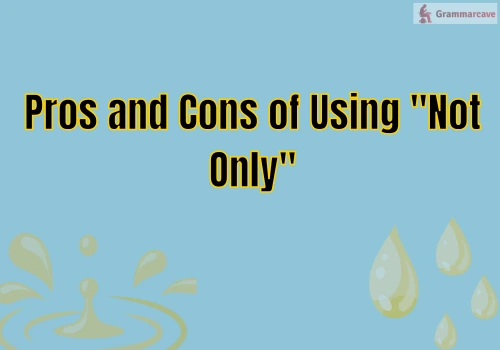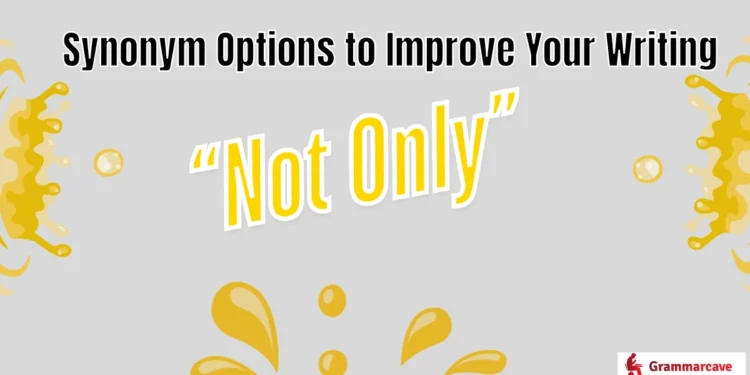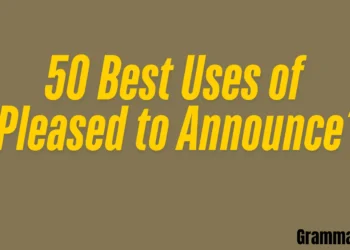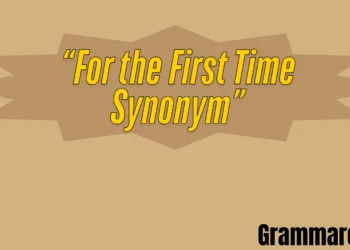When you really want to underscore an argument or illustrate that there’s more than one side to the story, “not only” comes to mind. It is a phrase that helps express complex ideas while being concise at the same time. Like all expressions, “not only” can also be monotonous when overused. If you’re trying to enhance your writing or express your ideas differently, looking for synonyms for “not only” is the way to go. This guide provides just that. From not only to alternatives, this guide provides 35 different phrases, explains how to use them, and outlines the best context for each phrase. Whether writing a formal email or wanting to sound sophisticated in everyday conversation, these alternatives will ensure you articulate your thoughts effectively.
What Does “Not Only” Actually Mean?
In a nutshell, “not only” is used when you want to highlight two things — usually something unexpected or powerful — and how they go hand-in-hand. It’s almost always followed by something like “but also” to round out the sentence.
For example:
“She’s not only intelligent but also incredibly kind.”
This tells us she’s smart and kind, and the structure makes both qualities feel extra important.
Is It Okay to Use “Not Only” in Formal Settings?
Absolutely! “Not only” works in both professional writing and effortless exchanges. It’s genteel, precise, and conveys class to your communication—assuming it’s used correctly.
A suggestion: when creating something formal or for public consumption, ensure the sentence is engaging and flows seamlessly. An awkward pairing or too much emphasis can feel clunky or forced. But when used well, it elevates your tone and strengthens your message.
Pros and Cons of Using “Not Only”

Let’s take a quick look at why you should (and sometimes shouldn’t) reach for this phrase:
Advantages
- It adds emphasis and depth. You are proving that there is more than just superficial scrutiny.
- It enhances the overall quality and professionalism of your writing.
- It’s excellent for comparisons or building suspense. People want to hear what’s coming next.
- It can improve rhythm and flow. It is beneficial in speeches, essays, or storytelling.
Disadvantages
- It’s easy to overuse. Too many “not only… but also” constructions can make your writing sound formulaic.
- It can be tricky to structure. If there is a discrepancy in the sentence balance, it can easily overwhelm readers.
- Everyday speech may come off as overly stilted or formal.
- It may overshadow simpler alternatives. Sometimes, plain language is more effective.
1. Mutually Reinforcing
Meaning: Reciprocal strengthening
Definition: Elements that boost each other
Detailed Explanation: Systems theory concept
Example Scenario: “These policies are mutually reinforcing, each making the other more effective.”
Best Use: Complex system analysis
Worst Use: Independent elements
Tone: Academic, Strategic
2. Multifaceted in Nature
Meaning: Many-sided
Definition: Complex with multiple aspects
Detailed Explanation: Sophisticated complexity descriptor
Example Scenario: “The problem is multifaceted in nature, involving…”
Best Use: Complex system descriptions
Worst Use: Simple concepts
Tone: Academic, sophisticated
3. Comprehensive in Effect
Meaning: Thorough impact
Definition: Affecting multiple areas
Detailed Explanation: Suggests wide-ranging consequences
Example Scenario: “The policy was comprehensive in effect, changing both…”
Best Use: Policy analysis, large-scale changes
Worst Use: Limited impacts
Tone: Authoritative, impactful
4. With Dual Outcomes
Meaning: Two results
Definition: Produces pair of consequences
Detailed Explanation: Balanced results description
Example Scenario: “The treatment works with dual outcomes: symptom relief and…”
Best Use: Medical, scientific, or business results
Worst Use: Single-outcome situations
Tone: Empirical, balanced
5. In Addition To
Meaning: Adds supplementary information.
Definition: Lists extra elements without surprise.
Detailed Explanation: A neutral, additive phrase that smoothly introduces additional points, often used in formal or structured writing.
Example: In addition to his salary, he receives health benefits.”
Best Use: Reports, resumes, or lists.
Worst Use: When dramatic emphasis is needed.
Tone: Neutral, professional, and straightforward.
6. It’s This and So Much More
Meaning: Expansive declaration
Definition: Acknowledges surface quality while hinting at depth
Detailed Explanation: Marketing-style phrasing suggesting hidden value
Example Scenario: “Our service is fast delivery, and so much more.”
Best Use: Advertising copy, promotional materials
Worst Use: Technical specifications
Tone: Promotional, enthusiastic
7. Together With
Meaning: Emphasizes joint action or combination
Definition: Indicates elements working/occurring in unison
Detailed Explanation: Stronger than “along with,” this phrase highlights active collaboration or simultaneous occurrence. It suggests synergy between the elements mentioned, making it powerful for showing teamwork or combined effects.
Example Scenario: “The new medication and physical therapy show promising results.”
Best Use: Scientific studies, team achievements, and when showing complementary actions
Worst Use: When describing separate or sequential events
Tone: Unified; emphasizes partnership
8. In Conjunction With
Meaning: Formal indication of coordinated elements
Definition: Shows planned, purposeful combination
Detailed Explanation: The most formal option in this group originates from legal and academic contexts. It implies intentional, often systematic, coordination between elements for a specific purpose.
Example Scenario: “This treatment is used with traditional therapies.”
Best Use: Research papers, legal documents, and technical manuals
Worst Use: Everyday conversation or creative writing
Tone: Highly formal; authoritative
9. Parallel To
Meaning: Indicates simultaneous similarity
Definition: Shows comparable development or characteristics
Detailed Explanation: Draws comparison between concurrent developments. It is helpful in showing how different elements follow similar patterns or principles without directly interacting.
Example Scenario: “The company’s growth ran parallel to industry trends.”
Best Use: Business analysis, historical comparisons, and scientific observations
Worst Use: When describing direct relationships or causes
Tone: Academic; comparative
10. Complementing
Meaning: Suggests harmonious enhancement
Definition: Indicates elements that mutually improve each other
Detailed Explanation: From “complement” (something that completes), this verb form shows how elements bring out each other’s strengths. Often used in design, food, and relationship contexts.
Example Scenario: “The software update focuses on complementing existing features.”
Best Use: Design discussions, partnership descriptions, and creative collaborations
Worst Use: When elements are in competition or conflict
Tone: Positive; emphasizes harmony
11. Reinforcing
Meaning: Strengthening or supporting
Definition: Adding elements that confirm or bolster
Detailed Explanation: Implies making something stronger or more durable, physically or conceptually. The added element validates or supports the original point.
Example Scenario: “The new data is reinforcing our initial hypothesis.”
Best Use: Arguments, scientific research, and structural descriptions
Worst Use: When introducing contradictory or neutral information
Tone: Assertive; supportive
12. Two-in-One Scenario
Meaning: Combined situation
Definition: Two elements in a single package
Detailed Explanation: Marketing-style efficiency claim
Example Scenario: “This creates a two-in-one scenario: training and team-building.”
Best Use: Promotional contexts
Worst Use: Technical documentation
Tone: Commercial, efficient
13. Beyond Simply
Meaning: Transcends basic understanding
Definition: Moves past superficial interpretations
Detailed Explanation: This phrase invites deeper consideration, suggesting layers or complexities are not immediately apparent.
Example Scenario: “This policy affects us beyond financial considerations; it impacts our core values.”
Best Use: Complex analyses or philosophical discussions
Worst Use: Simple, straightforward explanations
Tone: Thoughtful, profound
14. Not to Mention
Meaning: Introducing an additional important point
Definition: Used to add information that strengthens the argument
Detailed Explanation: Often implies the added point is significant yet possibly overlooked, reinforcing the main argument.
Example Scenario: “The car has great fuel efficiency and impressive safety features.”
Best Use: Strengthening arguments or sales pitches
Worst Use: When the additional point is trivial or unrelated
Tone: Conversational, persuasive
15. With Multiple Dimensions
Meaning: Multi-angled
Definition: Existing in several aspects
Detailed Explanation: Spatial metaphor for complexity
Example Scenario: “The challenge has multiple dimensions: technical, financial…”
Best Use: Complex problem-solving
Worst Use: Simple topics
Tone: Analytical, thorough
16. Even Further
Meaning: Extending beyond current limits
Definition: Taking something to greater extremes
Detailed Explanation: Suggests progression beyond an already significant point.
Example Scenario: “She improved her time, and this year pushed even further.”
Best Use: Describing progressive achievement
Worst Use: Static situations
Tone: Progressive, ambitious
17. All the More
Meaning: To a greater degree
Definition: Used to emphasize increased significance
Detailed Explanation: Indicates that something becomes more significant because of additional factors.
Example Scenario: “His apology makes his actions all the more confusing.”
Best Use: Paradoxical situations or reinforced qualities
Worst Use: Simple, straightforward statements
Tone: Reflective, emphatic
18. Just As… So Too
Meaning: Parallel comparison
Definition: Shows equivalent relationships
Detailed Explanation: Formal construction drawing deliberate parallels between two situations or concepts.
Example Scenario: “Just as plants need sunlight, so do businesses need innovation.”
Best Use: Formal comparisons and analogies
Worst Use: Casual conversation
Tone: Academic, rhetorical
19. Similarly
Meaning: In like manner
Definition: Indicates comparable characteristics
Detailed Explanation: Points out analogous qualities without the formality of “just as…so too.”
Example Scenario: “The first product succeeded; similarly, the second shows promise.”
Best Use: Drawing parallels in analysis
Worst Use: When differences are more important than similarities
Tone: Neutral, comparative
20. Equally
Meaning: To the same degree
Definition: Indicates matching importance
Detailed Explanation: Suggests balanced significance between elements.
Example Scenario: “Speed is important, but accuracy is equally crucial.”
Best Use: Balancing arguments or priorities
Worst Use: When one element is more important
Tone: Fair, measured
20. Likewise
Meaning: In the same way
Definition: Indicates identical application
Detailed Explanation: More formal than “similarly,” often used in academic or professional contexts.
Example Scenario: “The theory applies to physics; likewise, it works in economics.”
Best Use: Academic papers or professional reports
Worst Use: Casual observations
Tone: Formal, scholarly
21. In the Same Way
Meaning: Analogous manner
Definition: Identical mode of operation
Detailed Explanation: Concrete comparison showing identical processes or effects.
Example Scenario: “The new model functions in the same way as the original.”
Best Use: Technical explanations
Worst Use: When differences matter
Tone: Practical, descriptive
_
22. By the Same Token
Meaning: For the same reasons
Definition: Logical equivalence
Detailed Explanation: Indicates that the same logic or principle applies to another case.
Example Scenario: “We reward innovation; by the same token, we should recognize effort.”
Best Use: Logical arguments and policy-making
Worst Use: Emotional appeals
Tone: Logical, reasonable
23. Correspondingly
Meaning: In a related manner
Definition: Proportional relationship
Detailed Explanation: Shows a direct relationship or parallel between elements.
Example Scenario: “As demand increased, correspondingly, so did prices.”
Best Use: Showing cause-effect relationships
Worst Use: Unrelated concepts
Tone: Analytical, precise
24. Mirroring This
Meaning: Reflecting similarly
Definition: Direct parallel
Detailed Explanation: Creates a vivid image of one thing reflecting another’s qualities.
Example Scenario: “The east coast sales grew, mirroring this trend in the west.”
Best Use: Visual comparisons and trend analysis
Worst Use: When differences are important
Tone: Visual, comparative
25. Following Suit
Meaning: Doing the same
Definition: Adopting similar actions
Detailed Explanation: From card games, meaning to play the same suit. Implies conscious emulation.
Example Scenario: “After one bank lowered rates, others followed suit.”
Best Use: Business or social trends
Worst Use: Independent actions
Tone: Observational, trend-focused
26. In a Similar Vein
Meaning: Of comparable nature
Definition: Related in style or substance
Detailed Explanation: Suggests things belong to the same category or approach.
Example Scenario: “His later works, in a similar vein, explore existential themes.”
Best Use: Artistic or thematic analysis
Worst Use: Technical comparisons
Tone: Literary, stylistic
27. In Parallel With
Meaning: Simultaneous similar development
Definition: Occurring alongside with comparable characteristics
Detailed Explanation: Suggests two elements developing simultaneously in similar ways without direct interaction
Example Scenario: “Our sales grew in parallel with industry trends.”
Best Use: Business analysis, trend reporting
Worst Use: Describing direct relationships
Tone: Observational, analytical
28. Not Limited To
Meaning: Inclusive expansion
Definition: Indicates broader application than initially apparent
Detailed Explanation: Explicitly states that examples given don’t represent the full scope
Example Scenario: “Benefits include, but are not limited to, health insurance and retirement plans.”
Best Use: Legal documents, comprehensive lists
Worst Use: When complete information is available
Tone: Precise, formal
29. Reflecting Both…And
Meaning: Dual representation
Definition: Embodies two qualities simultaneously
Detailed Explanation: Shows how something manifests multiple characteristics
Example Scenario: “The design reflects both innovation and practicality.”
Best Use: Product descriptions, artistic analysis
Worst Use: When focusing on singular qualities
Tone: Balanced, descriptive
30. As Demonstrated By Both
Meaning: Evidenced in multiple ways
Definition: Proven through dual examples
Detailed Explanation: Uses concrete examples to establish a pattern
Example Scenario: “The theory holds, as demonstrated by laboratory and field tests.”
Best Use: Scientific writing, evidence-based arguments
Worst Use: Anecdotal situations
Tone: Empirical, authoritative
31. Echoed In Both
Meaning: Recurring similarity
Definition: Repeated pattern across instances
Detailed Explanation: Suggests a theme or principle manifests consistently
Example Scenario: “This concern is echoed in employee surveys and exit interviews.”
Best Use: Identifying patterns across data sources
Worst Use: Unique occurrences
Tone: Observational, pattern-focused
32. This Pattern Includes
Meaning: Comprehensive incorporation
Definition: Encompassing multiple elements
Detailed Explanation: Explicitly states that examples are part of a larger trend
Example Scenario: “This pattern includes recent graduates and mid-career professionals.”
Best Use: Demographic analysis, trend reporting
Worst Use: Isolated incidents
Tone: Scholarly, inclusive
33. Illustrated By Not Just
Meaning: Demonstrated through multiple examples
Definition: Shown via diverse evidence
Detailed Explanation: Uses examples to prove broader applicability
Example Scenario: “The principle is illustrated by not just Case A, but also Cases B through
Best Use: Academic papers, legal arguments
Worst Use: When a single example suffices
Tone: Evidentiary, thorough
34. Derived From Both
Meaning: Originating in multiple sources
Definition: Having dual foundations
Detailed Explanation: Shows composite origins of something
Example Scenario: “The methodology is derived from qualitative and quantitative approaches.”
Best Use: Research methodologies, hybrid systems
Worst Use: Single-source situations
Tone: Technical, precise
35. Established Through Both
Meaning: Verified multiple ways
Definition: Confirmed by different means
Detailed Explanation: Indicates robust verification process
Example Scenario: “The findings were established through experimentation and observation.”
Best Use: Scientific validation, quality assurance
Worst Use: Anecdotal claims
Tone: Authoritative, rigorous
36. This Phenomenon Involves
Meaning: Complex inclusion
Definition: Encompassing multiple factors
Detailed Explanation: Presents a situation as multifaceted
Example Scenario: “This phenomenon involves both biological and environmental factors.”
Best Use: Complex system analysis
Worst Use: Simple explanations
Tone: Scholarly, comprehensive
37. From Both a…And…Standpoint
Meaning: Multiple perspectives
Definition: Considering different viewpoints
Detailed Explanation: Examines an issue through distinct lenses
Example Scenario: “We analyzed this from a financial and ethical standpoint.”
Best Use: Multidisciplinary analysis
Worst Use: Single-perspective discussions
Tone: Analytical, balanced
38. Delivers Both…And
Meaning: Dual outcomes
Definition: Provides two benefits simultaneously
Detailed Explanation: Emphasizes comprehensive results
Example Scenario: “The program delivers immediate relief and long-term solutions.”
Best Use: Product benefits, program outcomes
Worst Use: When focusing on singular results
Tone: Promotional, results-oriented
39. Comprising Both
Meaning: Inclusive constitution
Definition: Made up of two elements
Detailed Explanation: Describes fundamental composition
Example Scenario: “The team comprises both veterans and newcomers.”
Best Use: Organizational structure, material composition
Worst Use: When elements are peripheral
Tone: Structural, factual
40. Offers Not Only…But Also
Meaning: Comprehensive provision
Definition: Provides multiple benefits/features
Detailed Explanation: Traditional “not only” alternative with emphasis on offerings
Example Scenario: “The course offers both theory and practical applications.”
Best Use: Educational programs, service descriptions
Worst Use: When describing limitations
Tone: Informative, comprehensive
FAQs
What does “not only” mean in English grammar?
It introduces two related ideas, emphasizing both, but especially the second. Often paired with “but also” for impact.
Is “not only” used in formal writing?
Yes, it’s common in formal writing to add emphasis and clarity. Just ensure correct grammar.
Can I start a sentence with “not only”?
Yes, but maintain proper subject-verb order.It often leads to inversion.
Why do people use “not only… but also”?
To highlight two crucial points or qualities.It makes writing more persuasive.
Is “not only” the same as “also”?
No, “not only” adds contrast while “also” adds. They’re used differently.
Should I use a comma after “not only”?
Usually, no, unless separating long clauses. It depends on sentence complexity.
Can “not only” be followed by a negative verb?
Yes, as long as the meaning stays clear. E.g., “Not only didn’t he go…”
Conclusion
It stresses the first point while constructing the second, which is often more impressive.
Authors and speakers deploy these as rhythmic and persuasive devices that create heightened differences. Their forms enable shifts in register—from formal to casual. When practiced properly, they promote clarity, breadth, and participation. They can also constrict ideas, heighten differences, combine ideas, broaden perspectives, and engage in communication. Overuse, misuse, and reliance are common causes of murky or uncomfortable sentences.








